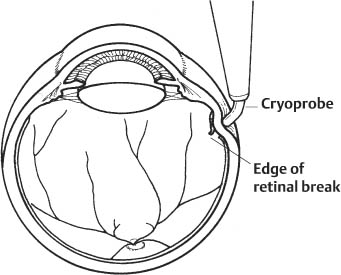65
Retinal Cryotherapy
Indications
1. Prophylaxis of selected retinal tears and areas of abnormal vitreoretinal adhesion (e.g., lattice degeneration).
2. Rare cases of progressive retinoschisis.
3. Treatment of selected retinal tumors and vascular malformations (e.g., Coats disease).
4. Peripheral panretinal cryotherapy to induce regression of neovascularization in:
a. Selected cases of neovascular glaucoma.
b. Proliferative retinopathies refractory to panretinal photocoagulation (PRP) or in eyes in which PRP is not possible (e.g., media opacities).
Preoperative Procedure
1. Complete retinal evaluation: Identify and draw all retinal breaks or other areas of pathology (e.g., lattice degeneration, retinal telangiectasia).
2. Dilate pupil (e.g., cyclopentolate 1% + phenylephrine 2.5%).
Instrumentation
 Indirect ophthalmoscope
Indirect ophthalmoscope
 Scleral depressor
Scleral depressor
 Cryosurgical unit with retinal cryoprobe
Cryosurgical unit with retinal cryoprobe
 Tuberculin syringe and 5/8-inch 30 gauge needle
Tuberculin syringe and 5/8-inch 30 gauge needle
 2% lidocaine without epinephrine
2% lidocaine without epinephrine
 Lid speculum (preferably wire type)
Lid speculum (preferably wire type)
Operative Procedure
1. Treatment of retinal breaks
a. Localize and draw all retinal breaks (indirect ophthalmoscope, scleral depressor).
b. Open gas valve and test cryoprobe (desired temperature should be –60 to –80°C; usually requires nitrogen gas tank pressure > 600 psi).
c. Apply anesthesia.
i. Subconjunctival lidocaine 2% without epinephrine to quadrants that will be treated.
ii. Retrobulbar anesthesia (± lid block) may be used in patients receiving extensive treatment (e.g., panretinal cryopexy) but usually is not necessary if extensive subconjunctival anesthesia is used.

Figure 65.1






